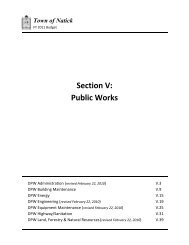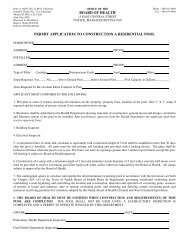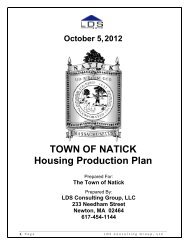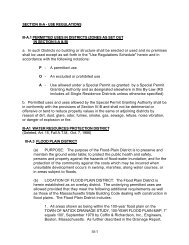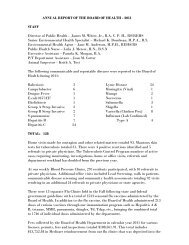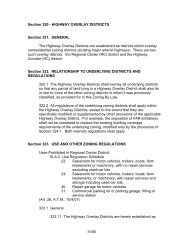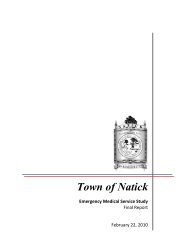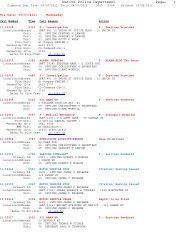Open Space and Recreation Plan - Town of Natick
Open Space and Recreation Plan - Town of Natick
Open Space and Recreation Plan - Town of Natick
Create successful ePaper yourself
Turn your PDF publications into a flip-book with our unique Google optimized e-Paper software.
Draft 9-16-11<br />
Employment Trends<br />
<strong>Natick</strong> is an economically vibrant community, with a low unemployment rate <strong>and</strong> is known as a<br />
business-friendly community. As a testament to the desirability <strong>of</strong> <strong>Natick</strong>, many major employers<br />
have chosen to locate their world or national headquarters in <strong>Natick</strong>, including: Cognex, MathWorks,<br />
Boston Scientific, <strong>and</strong> BJ’s, among others.<br />
That may account for <strong>Natick</strong>’s lower unemployment rate, historically lower by at least one-third than<br />
the statewide rate. In February 2011, the unemployment rate in <strong>Natick</strong> was 5.1%, compared with<br />
statewide rate <strong>of</strong> 8.7%. In 2011, <strong>Natick</strong>’s total labor force was 18,787. The average weekly wage<br />
increased from $910 in 2002 to $1128 in 2010. The largest sector in 2010 was Retail Trade with<br />
average monthly employment <strong>of</strong> 5,902, followed by Pr<strong>of</strong>essional <strong>and</strong> Technical Services (5,003),<br />
Education <strong>and</strong> Health Services (4,462), <strong>and</strong> Leisure <strong>and</strong> Hospitality (2,301).<br />
D. Growth <strong>and</strong> Development Patterns<br />
Patterns <strong>and</strong> Trends<br />
<strong>Natick</strong>’s commercial center began in the south <strong>and</strong> shifted north in several stages, following the<br />
development <strong>of</strong> the local transportation system. In the mid-17 th century <strong>Natick</strong> was settled on the<br />
Charles River, in what is now South <strong>Natick</strong>. In the mid-19 th century the railroad hastened<br />
development <strong>of</strong> what became downtown <strong>Natick</strong>. With the advent <strong>of</strong> the automobile in the 20th<br />
century, commercial activity moved further northward to Route 9 <strong>and</strong> finally toward the<br />
Massachusetts Turnpike’s Exit 13.<br />
In the 19th century, in <strong>Natick</strong> <strong>and</strong> throughout Massachusetts, the economy shifted from agricultural to<br />
industrial. <strong>Natick</strong>’s geography was dramatically changed in 1835, when the railroad connecting<br />
Boston <strong>and</strong> Worcester was built through the geographical center <strong>of</strong> town. The area around the train<br />
station became known as downtown <strong>Natick</strong>, which quickly surpassed South <strong>Natick</strong> in population <strong>and</strong><br />
economic activity. The railroad made downtown <strong>Natick</strong> an ideal site for new factories, <strong>and</strong> housing<br />
for the workers sprouted up nearby. South <strong>Natick</strong> experienced some <strong>of</strong> this type <strong>of</strong> growth, although<br />
to a much lesser extent. Maps from the late 1800s show <strong>Natick</strong> as two distinct communities –<br />
downtown <strong>Natick</strong> <strong>and</strong> South <strong>Natick</strong>. In other areas <strong>of</strong> <strong>Natick</strong>, ab<strong>and</strong>oned farml<strong>and</strong> reverted back to<br />
woods. Between 1800 <strong>and</strong> 1900, <strong>Natick</strong>’s population increased tenfold, from about 900 to 9,000. In<br />
1900, nearly 2,000 persons were employed in manufacturing, <strong>and</strong> only 123 in agriculture.<br />
In the 20th Century as manufacturing declined, <strong>Natick</strong> became a bedroom community <strong>of</strong> Boston. By<br />
1950, two-thirds <strong>of</strong> <strong>Natick</strong>’s full-time workers were employed outside <strong>of</strong> <strong>Natick</strong>, including Boston.<br />
Workers could live in downtown <strong>Natick</strong> <strong>and</strong> easily commute by train or car to their jobs. In the<br />
1930s, Route 9 was built as the state’s first divided highway, allowing easy automobile access to<br />
Boston or to Worcester. In 1957, the Massachusetts Turnpike was constructed along the old aqueduct<br />
right-<strong>of</strong>-way, with Exit 13 at the <strong>Natick</strong>-Framingham border. The Turnpike, along with the existing<br />
Route 9, gave commuters access to Boston, as well as new high technology jobs located along Route<br />
128 to the east <strong>and</strong> Route 495 to the west<br />
13



